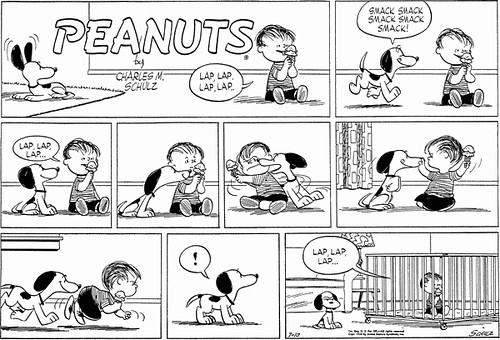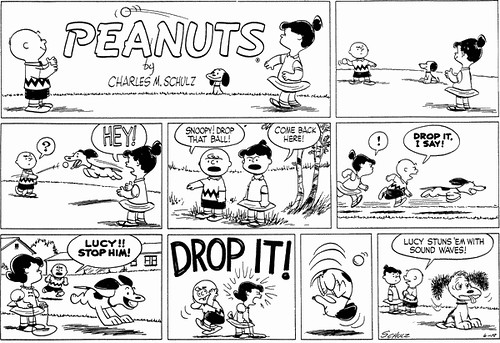Sunday, August 7 isn't on the gocomics site.
August 7:
Charlie Brown experiencing this kind of outburst is rare, through the overall history of the strip. This is more the kind of thing the other characters would do, although CB will do it if it regards someone he really admires. Less often Davy Crockett, more often Joe Shlabotnik.
August 8:
Linus hasn't spoken a word to another person yet, but he plays baseball. (Of course, Snoopy never speaks to another person -- or rather, doesn't say things other than "Boo.") Everyone remember Schroeder-the-musician, but Schroeder-the-catcher appears frequently, if less distinctively.
August 9:
Canine prodigies are disconcerting. Sarcastic ones moreso.
August 10:Yeah Linus, I know how you feel. The blanket hasn't become a big element of the strip yet, but we're getting there.
August 11:
How does Schroeder know about used cars? I like how the kids don't refer to the baby sitters by name, just by their attributes and reputation. It's an impersonal relationship, that between the high school student and her temporary charges. The most legendary babysitter in comics would have to be Calvin's nemesis Rosalyn. It's really difficult to picture a character like her in Peanuts, and not just because she's an adult.
August 12:
Charlie Brown has mostly laughed at this kind of rejection up to now, but this is getting more to his familiar personality from later strips.
Aside:
Since the last post, the comics world took a grevious blow when Richard Thompson, creator of the best modern comic strip going by a wide margin, Cul De Sac, had to lay down his pen due to encroaching Parkinson's Disease. I'm sorry I wasn't about to work in more references to it in these posts; it is wonderful in a way that fans of Peanuts and Calvin and Hobbes will find familiar, but still manages to be distinct from both of them in both style and tone. Alice is kind of like Calvin but more realistic and much more random; Petey is like Charlie Brown except much more introverted and nervous. The strip ended just after its fifth birthday, and in far fewer newspapers than you'd expect from its extreme brilliance, but I'm still suffering from a strong sense of deja vu from when C&H closed up shop. Thompson says he's quitting because the disease made it hard to keep up with the strong deadlines of a newspaper strip, so I'm hoping, kind of like Michael J. Fox, that we haven't heard the last from him, or his brilliant creation maybe in some other form.





















































